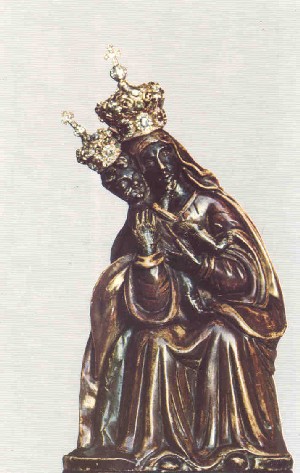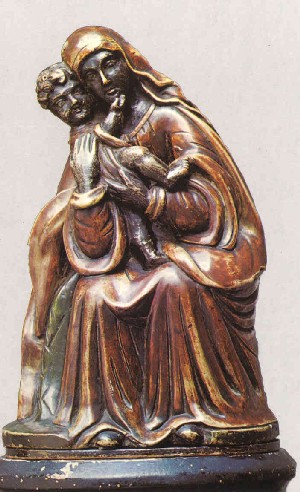Our Lady of Auvergne
Our Lady of Auvergne
Q: A missionary priest from the region of Auvergne in France brought a Pieta carved from wood to a parish hesitated in Ft. Saskatchewan, Canada. The people of the parish have provided a history of the parish and a picture of the statue. Can you advise of the tradition of Our Lady of Auvergne. Are there special prayers or devotions?
A: The region of Auvergne has three dioceses (Clermont-Ferrand, Moulins and Saint-Flour). Each one of these dioceses has a good number of Marian sanctuaries. None of them seems to correspond to the name you gave us: Our Lady of Auvergne. It may be that the name is a neologism created for the purpose of rallying immigrants from different places in Auvergne. It would be useful to investigate the exact geographical origin in Auvergne of the missionary priest and/or of the people he ministered to. The actual picture could be useful, too, provided it is a copy of one of the many Mary representations and titles in Auvergne. There are some Pietas but most of the old Mary sculptures are so-called majestis, representations of the Enthroned Madonna.

NOTRE DAME D'ORCIVAL The village of Orcival is located in the Vale of Silouet, 26 km. from Clermont-Ferrand, west of Mont-Domes and north of Mont-Dore. The name of the hamlet is said to come from the Latin: Ursorum Vallis (Valley of the Bears).
The church of Notre-Dame d'Orcival is one of the most beautiful in Auvergne. The image of Mary also goes by the name Notre-Dame des Fers (Our Lady of the Fetters), because of the many slaves and captives who were miraculously delivered through her intercession.
During the reign of Louis XIV, the church was despoiled of its treasures to make up for the deficiencies of the royal treasury. It was despoiled again during the Revolution in 1793. Much damage was done to the interior of the church at that time.
Once a year on the Feast of the Ascension, the statue is taken in procession to the top of a nearby hill. A monument is found there called Our Lady's tomb. It marks the spot where the statue was buried at a time when the area was being invaded by barbarians. (The time this occurred is not precisely dated.)
One source claims that during the Revolution the statue was hidden in the walls of the church. Beginning in 1800 it was returned to its rightful place.
The image is 70 cm high and is dated to the twelfth century. The figures are rather stiff; the garments with numerous parallel folds; very careful details in the rendering of the hairs. Save for the faces, hands and feet, the figures are covered with plates of silver or with copper silvered over. Mary holds her Son with her left hand. The Infant, resting on her knees, holds a book in his left hand and raises his right in blessing. There is a very strong resemblance between Mother and son. The latter looks as old as his mother. The artist was not concerned with depicting anything of the maternal affection of the mother nor of the filial affection of the son. He was more interested in showing forth the tremendous mystery of the Incarnation.

This spread to other countries. An example from Canada is included below -
The Statue's Travels
The choice being made, the statue was carefully packed and entrusted to the care of one of its future settlers, Mr. H. Schoefer from Clermont-Ferrand It was to be shipped with his own parcels. Mr. Schoefer embarked on a passenger-liner of the Allan Company taking with him about fifteen crates including the one with the statue. Little did he know the adventures this voyage would bring. The ocean was calm for the first few days. Suddenly a violent storm arose. The travelers were overcome with fright and superstition. They believed that somehow the statue and Mr. Schoefer were the cause of this terrifying storm and they were intent on throwing either or both overboard. The captain concerned with the safety of his passenger appointed two sailors to guard Mr. Schoefer and the statue for the remainder of the trip. The storm abated eventually and the ship arrived safely in Montreal. Mr. Schoefer traveled on to Swift Current and to the new settlement of Notre Dame d' Auvergne.
Mr. Schoefer received his parcels a few days later but the package containing the statue was not among them. There was fear that those who had objected to the presence of the statue onboard ship had found and destroyed it. Faced with such gloomy speculation, claims were immediately made to the Allan Company. They promised to investigate the matter. After an interminable wait, they were told that the statue was, for some inexplicable reason, on its way back to France. Mr. Schoefer doubled his efforts to have the statue shipped once again to Swift Current. Months later, information was received that a crate containing the statue had indeed been delivered to Swift Current. Mr. Louis de Cousbouc traveled the fifty long miles to the station to pick it up. Another bitter disappointment awaited him. The crate contained only bedclothes that did not even belong to Mr. Schoefer. A similarity of address was apparently the cause for error.
Another lengthy wait and more sincere praying took place before the statue finally arrived. It had been slightly damaged at one of its joints. Upon repair, it was discovered to be made of wood as hard as steel.
On May 30 1909, the statue was installed in the first chapel, built in Notre Dame d' Auvergne. A sanctuary was later added on to the chapel. The statue was placed above and slightly to the rear of the altar. A window reflected the sun creating a celestial aura of blue accentuated by velvet draperies. Thus the statue of Mary was held in reverence by the faithful and devout parishioners.
In the meantime, the railroad arrived, situated on the opposite side of the river from Notre Dame d' Auvergne. The settlers built their homes around the station. The settlement was a half-mile from the original site of the first chapel. So, in 1916, a new and bigger church was built in what was now officially called "Ponteix." The parish retained the name "Notre Dame d' Auvergne."
This church would be much bigger. Available space was made behind the sanctuary to allow an exterior niche… it was hoped that they could create a similar effect as that of the previous church. Unfortunately the architect's plan did not work out. The niche was placed too high causing inadequate light, and dust collected between the window darkening the room… failure! ... surrender! The statue of the Pietà, hidden from the people became obscure and ignored. There was mere mention of Mary's favors and blessings. The years of abundance were replaced by years of severe drought.
Where would we place this magnificent statue? After all, she was the patron of the parish. The lateral altars were already dedicated to St. Anne and to St. Joseph respectively. The transepts were reserved for the apparitions of Paray and Lourdes. Finally, remembering the crypts of the old Roman churches and the immense attraction it held for pilgrims, Fr. Royer decided he would move the statue to the basement. Space under the steeple tower gave sufficient light, and it had access to a stairway. A small chapel with a crypt-like altar were built... the statue was repainted and finally installed in its new location. The chapel was solemnly inaugurated on December 8, 1921, following an eloquent sermon by Rev. Fr. Maurice O.M.I. Devotion to Mary, Notre Dame d' Auvergne, grew ever stronger. His Excellency Mgr. Mathieu. granted a hundred days' indulgence to those who would pray at the crypt. In 1923 the church burned to the ground and through the heroic efforts of a local fireman, Wilfrid Liboiron, only the statue was saved from the fire.
The Statue Today
Vatican II has had a great influence on the changes and decor in the churches. All liturgical celebrations would be heard in the vernacular. The altar would be closer to the congregation and the priest would now be facing the people. Towards the end of the eighties, our church underwent a major remodeling project under the leadership of Fr. J.B. Pouliot, then pastor of the parish. The sanctuary was extended to accommodate the new altar, the pulpit, and celebrants' chairs. Thus it provided ample room to circulate for liturgies. Portions of the communion rail framed the sanctuary, providing a perfect location for the statue of Notre Dame. In full view to the people, it offered a place of dignity accessible for veneration and prayer.
Since 1934 an annual pilgrimage is held every July 16. It is a special day of devotion to our Blessed Mother. Following the evening Mass. the statue is carried, in a candlelight procession, through the streets of our town.
Mary, Mother of Christ, Woman for all times, in her divine wisdom, entrusted us with memorable words for all generations:
"Do whatever he tells you." (John 2:5)
Jesus, at the foot of the cross, gave her to us as Mother:
"This is your Mother." (John 19:27)
Courtesy of:
Paroisse Notre-Dame D' Auvergne Parish, P.O. Box 540, Ponteix, Saskatchewan, Canada S0N 1Z0
All About Mary includes a variety of content, much of which reflects the expertise, interpretations and opinions of the individual authors and not necessarily of the Marian Library or the University of Dayton. Please share feedback or suggestions with marianlibrary@udayton.edu.
